
Un aperçu des mots-clés relatifs au trafic. Ici, vous pouvez facilement rechercher des mots-clés et des définitions que vous ne connaissez pas encore.
More subjects
The death's head cockroach (Blaberus craniifer) is a species of cockroach belonging to the family Blaberidae. It is often confused with the discoid cockroach, Blaberus discoidalis, due to its similar appearance. It is distinguished by jet black cloak-like marking on its wings and a skull-shaped, amber/black marking on its pronotum. The name death's head comes from the markings on the top of the pronotum: 'cranii', which is Latin for 'of the head', and 'fer', meaning 'carry' or 'carrier'. Due to their unique appearance and certain characteristics, they make an easy to care for pet or display insect for entomologists and hobbyists. (Source: Wikipedia.org, CC BY-SA)
Ixodes scapularis is commonly known as the deer tick or black-legged tick (although some people reserve the latter term for Ixodes pacificus, which is found on the west coast of the US), and in some parts of the US as the bear tick. It was also named Ixodes dammini until it was shown to be the same species in 1993. It is a hard-bodied tick found in the eastern and northern Midwest of the United States as well as in southeastern Canada. It is a vector for several diseases of animals, including humans (Lyme disease, babesiosis, anaplasmosis, Powassan virus disease, etc.) and is known as the deer tick owing to its habit of parasitizing the white-tailed deer. It is also known to parasitize mice, lizards, migratory birds, etc. especially while the tick is in the larval or nymphal stage. (Source: Wikipedia.org, CC BY-SA)
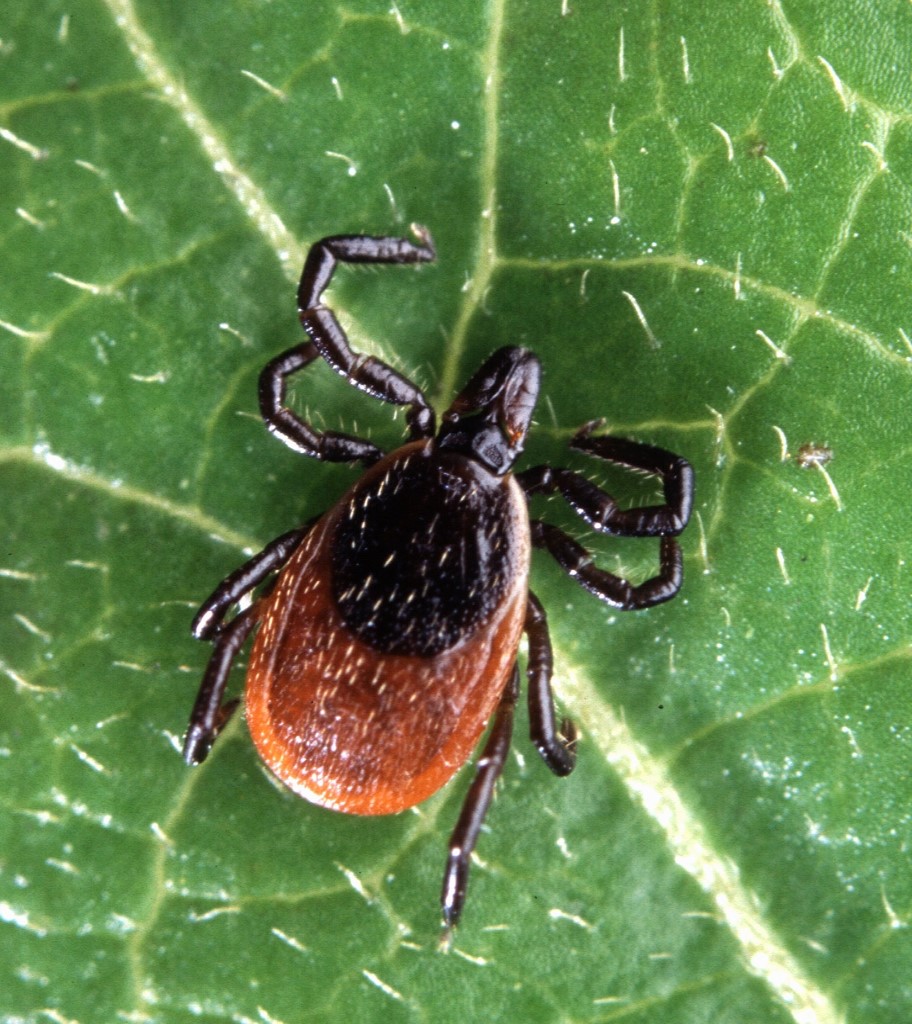 © Wikimedia.org/Scott Bauer, CC0
© Wikimedia.org/Scott Bauer, CC0
The desert locust (Schistocerca gregaria) is a species of locust, a periodically swarming, short-horned grasshopper in the family Acrididae. They are found primarily in the deserts and dry areas of northern and eastern Africa, Arabia, and southwest Asia. During population surge years, they may extend north into parts of western Spain and southern Italy, south into Eastern Africa, and east in northern India. The desert locust shows periodic changes in its body form and can change in response to environmental conditions, over several generations, from a solitary, shorter-winged, highly fecund, non-migratory form to a gregarious, long-winged, and migratory phase in which they may travel long distances into new areas. In some years, they may thus form locust plagues, invading new areas, where they may consume all vegetation including crops, and at other times, they may live unnoticed in small numbers. (Source: Wikipedia.org, CC BY-SA)
The devil's coach-horse beetle (Ocypus olens) is a species of beetle belonging to the large family of the rove beetles (Staphylinidae). It was originally included in the genus Staphylinus in 1764, and some authors and biologists still use this classification. These very common and widespread beetles are present in most of Europe and in North Africa. They have also been introduced to the Americas and parts of Australasia. They prefer areas with damp conditions and can be found from April to October in meadows, heath and moorland, woodlands, hedgerows, and parks and gardens. During the day, they commonly stay under logs, stones, or leaf litter. (Source: Wikipedia.org, CC BY-SA)
The diamondback moth (Plutella xylostella), sometimes called the cabbage moth, is a moth species of the family Plutellidae and genus Plutella. The small, grayish-brown moth sometimes has a cream-colored band that forms a diamond along its back. The species may have originated in Europe, South Africa, or the Mediterranean region, but it has now spread worldwide. The moth has a short life cycle (14 days at 25 °C), is highly fecund, and is capable of migrating long distances. Diamondback moths are considered pests as they feed on the leaves of cruciferous crops and plants that produce glucosinolates. However, not all of these plants are equally useful as hosts to the moth. Because of this, studies have suggested using wintercress as a trap crop around agricultural fields because diamondback moths are highly attracted to that plant but their larvae fail to survive when eggs are laid on it. (Source: Wikipedia.org, CC BY-SA)
Dermacentor variabilis, also known as the American dog tick or wood tick, is a species of tick that is known to carry bacteria responsible for several diseases in humans, including Rocky Mountain spotted fever and tularemia (Francisella tularensis). It is one of the best-known hard ticks. Diseases are spread when it sucks blood from the host. It may take several days for the host to experience symptoms. (Source: Wikipedia.org, CC BY-SA)
A dragonfly is a flying insect belonging to the infraorder Anisoptera below the order Odonata. About 3,000 extant species of true dragonfly are known. Most are tropical, with fewer species in temperate regions. Loss of wetland habitat threatens dragonfly populations around the world. Adult dragonflies are characterized by a pair of large, multifaceted compound eyes, two pairs of strong, transparent wings, sometimes with coloured patches, and an elongated body. Many dragonflies have brilliant iridescent or metallic colours produced by structural colouration, making them conspicuous in flight. An adult dragonfly's compound eyes have nearly 24,000 ommatidia each. (Source: Wikipedia.org, CC BY-SA)
Blaptica dubia, the Dubia roach, orange-spotted roach, Guyana spotted roach, or Argentinian wood roach, is a medium-sized species of cockroach which grows to around 40–45 mm (1.6–1.8 in). They are sexually dimorphic; adult males have full wings covering their body, while females have only tiny wing stubs - their tegmina (forewings) being around a fourth of their body length. Adults are dark brown to black with somewhat lighter orange spot/stripe patterning sometimes visible only in bright light. Coloration differs slightly with environment and diet from one colony to another. (Source: Wikipedia.org, CC BY-SA)
Dung beetles are beetles that feed on feces. Some species of dung beetles can bury dung 250 times their own mass in one night. Many dung beetles, known as rollers, roll dung into round balls, which are used as a food source or breeding chambers. Others, known as tunnelers, bury the dung wherever they find it. A third group, the dwellers, neither roll nor burrow: they simply live in dung. They are often attracted by the feces collected by burrowing owls. There are dung beetle species of various colors and sizes, and some functional traits such as body mass (or biomass) and leg length can have high levels of variability. (Source: Wikipedia.org, CC BY-SA)
Earwigs make up the insect order Dermaptera. With about 2,000 species in 12 families, they are one of the smaller insect orders. Earwigs have characteristic cerci, a pair of forcep-like pincers on their abdomen, and membranous wings folded underneath short, rarely used forewings, hence the scientific order name, 'skin wings'. Some groups are tiny parasites on mammals and lack the typical pincers. Earwigs are found on all continents except Antarctica. (Source: Wikipedia.org, CC BY-SA)
The European corn borer (Ostrinia nubilalis), also known as the European corn worm or European high-flyer, is a moth of the family Crambidae which includes other grass moths. It is a pest of grain, particularly maize (Zea mays). The insect is native to Europe, originally infesting varieties of millet, including broom corn. The European corn borer was first reported in North America in 1917 in Massachusetts, but was probably introduced from Europe several years earlier. Since its initial discovery in the Americas, the insect has spread into Canada and westward across the United States to the Rocky Mountains. The adult European corn borer is about 25 millimetres (0.98 in) long with a 26–30 millimetres (1.0–1.2 in) wingspan. The female is light yellowish brown with dark, irregular, wavy bands across the wings. The male is slightly smaller and darker. (Source: Wikipedia.org, CC BY-SA)
The Lampyridae are a family of elateroid beetles with more than 2,000 described species, many of which are light-emitting. They are soft-bodied beetles commonly called fireflies, lightning bugs, or glowworms for their conspicuous production of light, mainly during twilight, to attract mates. Light production in the Lampyridae is thought to have originated as an honest warning signal that the larvae were distasteful; this was co-opted in evolution as a mating signal in the adults. In a further development, female fireflies of the genus Photuris mimic the flash pattern of Photinus species to trap their males as prey. (Source: Wikipedia.org, CC BY-SA)
Flea, the common name for the order Siphonaptera, includes 2,500 species of small flightless insects that live as external parasites of mammals and birds. Fleas live by ingesting the blood of their hosts. Adult fleas grow to about 3 millimetres (1⁄8 inch) long, are usually brown, and have bodies that are 'flattened' sideways or narrow, enabling them to move through their hosts' fur or feathers. They lack wings; their hind legs are extremely well adapted for jumping. Their claws keep them from being dislodged, and their mouthparts are adapted for piercing skin and sucking blood. They can leap 50 times their body length, a feat second only to jumps made by another group of insects, the superfamily of froghoppers. Flea larvae are worm-like, with no limbs; they have chewing mouthparts and feed on organic debris left on their hosts' skin. (Source: Wikipedia.org, CC BY-SA)
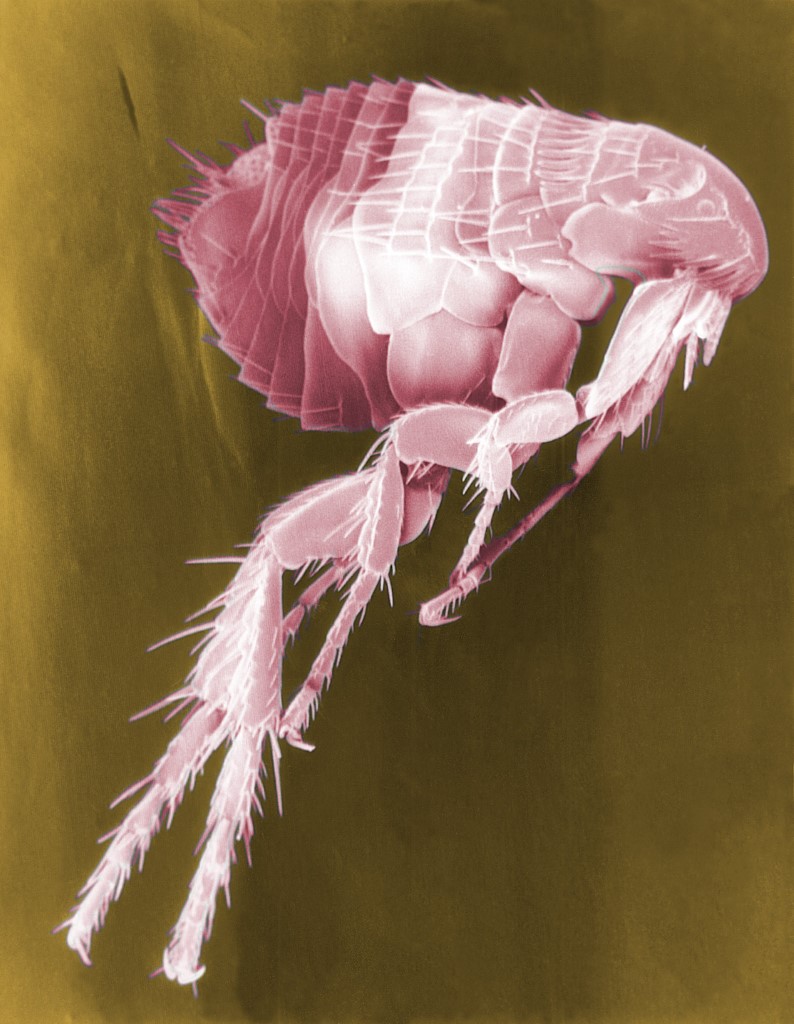 © Wikimedia.org/CDC/Janice Haney Carr, CC0
© Wikimedia.org/CDC/Janice Haney Carr, CC0
The Florida woods cockroach or palmetto bug (Eurycotis floridana) is a large cockroach species which typically grows to a length of 30–40 mm (1.2–1.6 in). When alarmed, adults can eject an extremely foul-smelling directional spray up to 1 m, which inspired several of its other common names: Florida skunk roach, Florida stinkroach, skunk cockroach, skunk roach, stinking cockroach, and stinkroach. Two other naming variations include Florida cockroach and Florida woods roach. (Source: Wikipedia.org, CC BY-SA)
Flies are insects of the order Diptera, the name being derived from the Greek δι- di- 'two', and πτερόν pteron 'wing'. Insects of this order use only a single pair of wings to fly, the hindwings having evolved into advanced mechanosensory organs known as halteres, which act as high-speed sensors of rotational movement and allow dipterans to perform advanced aerobatics. Diptera is a large order containing an estimated 1,000,000 species including horse-flies, crane flies, hoverflies and others, although only about 125,000 species have been described. (Source: Wikipedia.org, CC BY-SA)
Drosophila melanogaster is a species of fly (the taxonomic order Diptera) in the family Drosophilidae. The species is often referred to as the fruit fly or lesser fruit fly, or less commonly the 'vinegar fly' or 'pomace fly'. Starting with Charles W. Woodworth's 1901 proposal of the use of this species as a model organism, D. melanogaster continues to be widely used for biological research in genetics, physiology, microbial pathogenesis, and life history evolution. As of 2017, five Nobel Prizes have been awarded to drosophilists for their work using the insect. (Source: Wikipedia.org, CC BY-SA)
The giant leopard moth (Hypercompe scribonia) is a moth of the family Erebidae. They are distributed through North America from southern Ontario, and southern and eastern United States through New England, Mexico and south to Colombia. The obsolete name, Ecpantheria scribonia, is still occasionally encountered. This species has a wingspan of 76 mm (3 in). The wings of this moth are bright white with a pattern of neat black blotches, some solid and some hollow. The overside of the abdomen is dark blue with orange markings, while the underside is white with solid black spots, and males have a narrow yellow line on the sides. Their legs have black and white bands. Adult moths are strictly nocturnal and do not generally fly before nightfall. (Source: Wikipedia.org, CC BY-SA)
Glowworm or glow-worm is the common name for various groups of insect larvae and adult larviform females that glow through bioluminescence. They include the European common glow-worm and other members of the Lampyridae, but bioluminescence also occurs in the families Elateridae, Phengodidae and Rhagophthalmidae among beetles; as well as members of the genera Arachnocampa, Keroplatus and Orfelia among keroplatid fungus gnats. (Source: Wikipedia.org, CC BY-SA)
A gnat (/ˈnæt/) is any of many species of tiny flying insects in the dipterid suborder Nematocera, especially those in the families Mycetophilidae, Anisopodidae and Sciaridae. They can be both biting and non-biting. Most often they fly in large numbers, called clouds. 'Gnat' is a loose descriptive category rather than a phylogenetic or other technical term, so there is no scientific consensus on what constitutes a gnat. Some entomologists consider only non-biting flies to be gnats. Certain universities and institutes also distinguish eye gnats: the Smithsonian Institution describes them as 'non-biting flies, no bigger than a few grains of salt, ... attracted to fluids secreted by your eyes'. (Source: Wikipedia.org, CC BY-SA)
Grasshoppers are a group of insects belonging to the suborder Caelifera. They are among what is possibly the most ancient living group of chewing herbivorous insects, dating back to the early Triassic around 250 million years ago. Grasshoppers are typically ground-dwelling insects with powerful hind legs which allow them to escape from threats by leaping vigorously. As hemimetabolous insects, they do not undergo complete metamorphosis; they hatch from an egg into a nymph or 'hopper' which undergoes five moults, becoming more similar to the adult insect at each developmental stage. The grasshopper hears through the tympanal organ which can be found in the first segment of the abdomen attached to the thorax; while its sense of vision is in the compound eyes, the change in light intensity is perceived in the simple eyes (ocelli). At high population densities and under certain environmental conditions, some grasshopper species can change color and behavior and form swarms. Under these circumstances, they are known as locusts. (Source: Wikipedia.org, CC BY-SA)
The Sphingidae are a family of moths (Lepidoptera) called sphinx moths, also colloquially known as hawk moths, with many of their caterpillars known as “hornworms”; it includes about 1,450 species. It is best represented in the tropics, but species are found in every region. They are moderate to large in size and are distinguished among moths for their agile and sustained flying ability, similar enough to that of hummingbirds as to be reliably mistaken for them. Their narrow wings and streamlined abdomens are adaptations for rapid flight. The family was named by French zoologist Pierre André Latreille in 1802. (Source: Wikipedia.org, CC BY-SA)
The Hercules beetle (Dynastes hercules) is a species of rhinoceros beetle native to the rainforests of Central America, South America, and the Lesser Antilles. It is the longest extant species of beetle in the world, and is also one of the largest flying insects in the world. Adult body sizes (not including the thoracic horn) vary between 50 and 85 mm (2.0 and 3.3 in) in length and 29 and 42 mm (1.1 and 1.7 in) in width. Male Hercules beetles may reach up to 173 mm (7 in) in length (including the horn), making them the longest species of beetle in the world, if jaws and/or horns are included in the measurement. The size of the horn is naturally variable, more so than any variation of the size of legs, wings, or overall body size in the species. This variability results from developmental mechanisms that coincide with genetic predisposition in relation to nutrition, stress, exposure to parasites, and/or physiological conditions. (Source: Wikipedia.org, CC BY-SA)
Coscinocera hercules, the Hercules moth, is a moth of the family Saturniidae, endemic to New Guinea and northern Australia. The species was first described by William Henry Miskin in 1876. Adults have a wingspan of about 27 centimetres (11 in), making it the largest moth found in Australia, and its wings have the largest documented surface area (300 square centimeters) of any living insect. They are mainly colored golden-brown and white, with transparent spots on each of the four wing sections – the coloring and patterns between sexes is mostly static. However, adult males have longer, slimmer tails on their wings than females do, making it somewhat easy to differentiate them in this way. (Source: Wikipedia.org, CC BY-SA)
A honey bee (also spelled honeybee) is a eusocial flying insect within the genus Apis of the bee clade, all native to Afro-Eurasia. After bees spread naturally throughout Africa and Eurasia, humans became responsible for the current cosmopolitan distribution of honey bees, introducing multiple subspecies into South America (early 16th century), North America (early 17th century), and Australia (early 19th century). Honey bees are known for their construction of perennial colonial nests from wax, the large size of their colonies, and surplus production and storage of honey, distinguishing their hives as a prized foraging target of many animals, including honey badgers, bears and human hunter-gatherers. Only eight surviving species of honey bee are recognized, with a total of 43 subspecies, though historically 7 to 11 species are recognized. Honey bees represent only a small fraction of the roughly 20,000 known species of bees. (Source: Wikipedia.org, CC BY-SA)
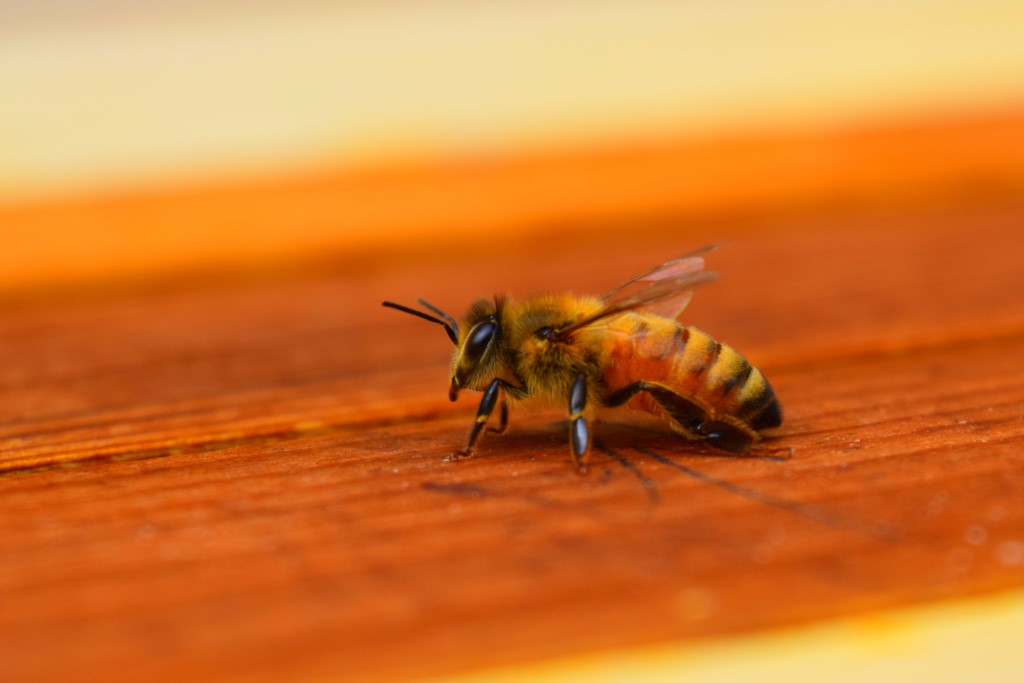 © Wikimedia.org/Tanner Smida, CC BY
© Wikimedia.org/Tanner Smida, CC BY
Hornets (insects in the genus Vespa) are the largest of the eusocial wasps, and are similar in appearance to their close relatives yellowjackets. Some species can reach up to 5.5 cm (2.2 in) in length. They are distinguished from other vespine wasps by the relatively large top margin of the head. Worldwide, 22 species of Vespa are recognized. Most species only occur in the tropics of Asia, though the European hornet (V. crabro), is widely distributed throughout Europe, Russia, North America, and north-eastern Asia. Wasps native to North America in the genus Dolichovespula are commonly referred to as hornets (e.g., baldfaced hornets), but are actually yellowjackets. (Source: Wikipedia.org, CC BY-SA)
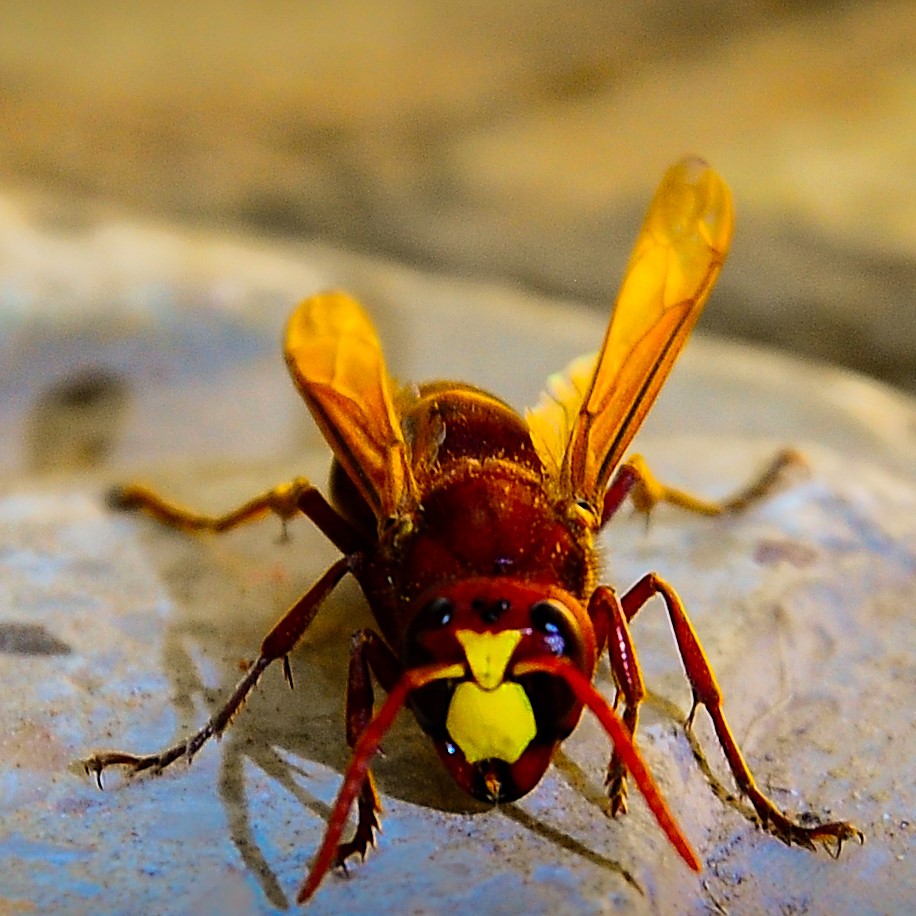 © Wikimedia.org/Mehdi Taba, CC BY-SA
© Wikimedia.org/Mehdi Taba, CC BY-SA
Horse-flies or horseflies are true flies in the family Tabanidae in the insect order Diptera. They are often large and agile in flight, and the females bite animals, including humans, to obtain blood. They prefer to fly in sunlight, avoiding dark and shady areas, and are inactive at night. They are found all over the world except for some islands and the polar regions (Hawaii, Greenland, Iceland). Both horse-flies and botflies (Oestridae) are sometimes referred to as gadflies. Adult horse-flies feed on nectar and plant exudates; the males have weak mouthparts and only the females bite animals to obtain enough protein from blood to produce eggs. The mouthparts of females are formed into a stout stabbing organ with two pairs of sharp cutting blades, and a spongelike part used to lap up the blood that flows from the wound. The larvae are predaceous and grow in semiaquatic habitats. (Source: Wikipedia.org, CC BY-SA)
The housefly (Musca domestica) is a fly of the suborder Cyclorrhapha. It is believed to have evolved in the Cenozoic Era, possibly in the Middle East, and has spread all over the world as a commensal of humans. It is the most common fly species found in houses. Adults are gray to black, with four dark, longitudinal lines on the thorax, slightly hairy bodies, and a single pair of membranous wings. They have red eyes, set farther apart in the slightly larger female. (Source: Wikipedia.org, CC BY-SA)
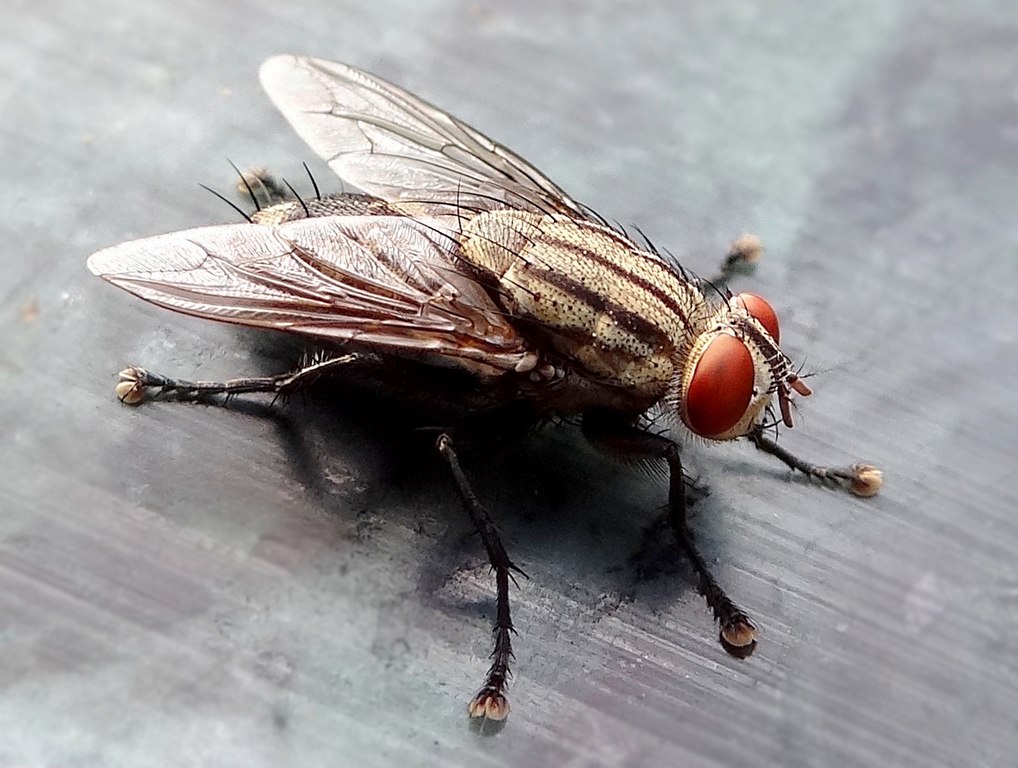 © Wikimedia.org/Gladson Machado, CC BY-SA
© Wikimedia.org/Gladson Machado, CC BY-SA
The hummingbird hawk-moth (Macroglossum stellatarum) is a species of hawk moth found across temperate regions of Eurasia. The species is named for its similarity to hummingbirds, as they feed on the nectar of tube-shaped flowers using their long proboscis while hovering in the air; this resemblance is an example of convergent evolution. The hummingbird hawk-moth was first described by Carl Linnaeus in his 1758 10th edition of Systema Naturae. As of 2018, its entire genome and mitogenome have been sequenced. (Source: Wikipedia.org, CC BY-SA)
Eacles imperialis, the imperial moth, is a Nearctic member of the family Saturniidae and subfamily Ceratocampinae. The species was first described by Dru Drury in 1773. The wingspan of an adult is between 80 and 175 mm (3+1⁄8 and 6+7⁄8 inches). There is a high amount of variation within this species. The colors of the adult are always primarily yellow with red, brown, and purple blotches but can vary distinctly on this. Light and dark morphs of this species are found in both northern and southern regions of their range. Individuals from the northern regions of their native range may tend to have fewer dark markings. Larvae can be small (approximately 10–15 mm long) and orange with black transverse bands and large spines in the first instar, to 3–5.5 inches (75–100 mm) long in the fifth instar with long hairs and shorter spines and color morphs varying between dark brown and burgundy with white spiracle patches, and green with yellow spiracle patches. (Source: Wikipedia.org, CC BY-SA)
The Indianmeal moth (Plodia interpunctella), also spelled Indian meal moth and Indian-meal moth, is a pyraloid moth of the family Pyralidae. Alternative common names are weevil moth, pantry moth, flour moth or grain moth. The almond moth (Cadra cautella) and the raisin moth (Cadra figulilella) are commonly confused with the Indian-meal moth due to similar food sources and appearance. The species was named for feeding on Indian meal or cornmeal, and does not occur natively in India. It is also not to be confused with the Mediterranean flour moth (Ephestia kuehniella), another common pest of stored grains. (Source: Wikipedia.org, CC BY-SA)
The Japanese beetle (Popillia japonica) is a species of scarab beetle. The adult measures 15 mm (0.6 in) in length and 10 mm (0.4 in) in width, has iridescent copper-colored elytra and a green thorax and head. It is not very destructive in Japan (where it is controlled by natural predators), but in North America and some regions of Europe is a noted pest to roughly 300 species of plants, including rose bushes, grapes, hops, canna, crape myrtles, birch trees, linden trees, and others.[citation needed] The adult beetles damage plants by skeletonizing the foliage (i.e., consuming only the material between a leaf's veins) as well as, at times, feeding on a plant's fruit. The subterranean larvae feed on the roots of grasses. (Source: Wikipedia.org, CC BY-SA)
Trichonephila clavata, also known as the Joro spider (ジョロウグモ(女郎蜘蛛、上臈蜘蛛, Jorō-gumo), is a member of the Trichonephila genus. The spider can be found throughout Japan (except Hokkaidō), Korea, Taiwan, China, and since 2020, much of northeastern Georgia and northwestern South Carolina in the United States. Due to its large size and the bright, unique colors of the female Trichonephila, the spider is well-favored in Japan.[citation needed] In 2014, scientists confirmed the first known occurrence of T. clavata in North America. In 2019, this species was moved from the genus Nephila to Trichonephila. T. clavata's congener Trichonephila plumipes is commonly found in Australia. It also was moved from Nephila to Trichonephila, along with 10 other species. (Source: Wikipedia.org, CC BY-SA)
Coccinellidae (/ˌkɒksɪˈnɛlɪˌdiː/) is a widespread family of small beetles ranging in size from 0.8 to 18 mm (0.03–0.7 in). They are commonly known as ladybugs in North America and ladybirds in Great Britain. Some entomologists prefer the names ladybird beetles or lady beetles as they are not true bugs. Many of the species have conspicuous aposematic colours and patterns, such as red with black spots, that warn potential predators that they are distasteful. The majority of the more than 6000 described species are generally considered beneficial insects, because many prey on herbivorous hemipterans such as aphids or scale insects, which are agricultural pests. Many coccinellids lay their eggs directly in aphid and scale insect colonies, ensuring their larvae have an immediate food source. However, some species such as the herbivorous Mexican bean beetle are agricultural pests. (Source: Wikipedia.org, CC BY-SA)
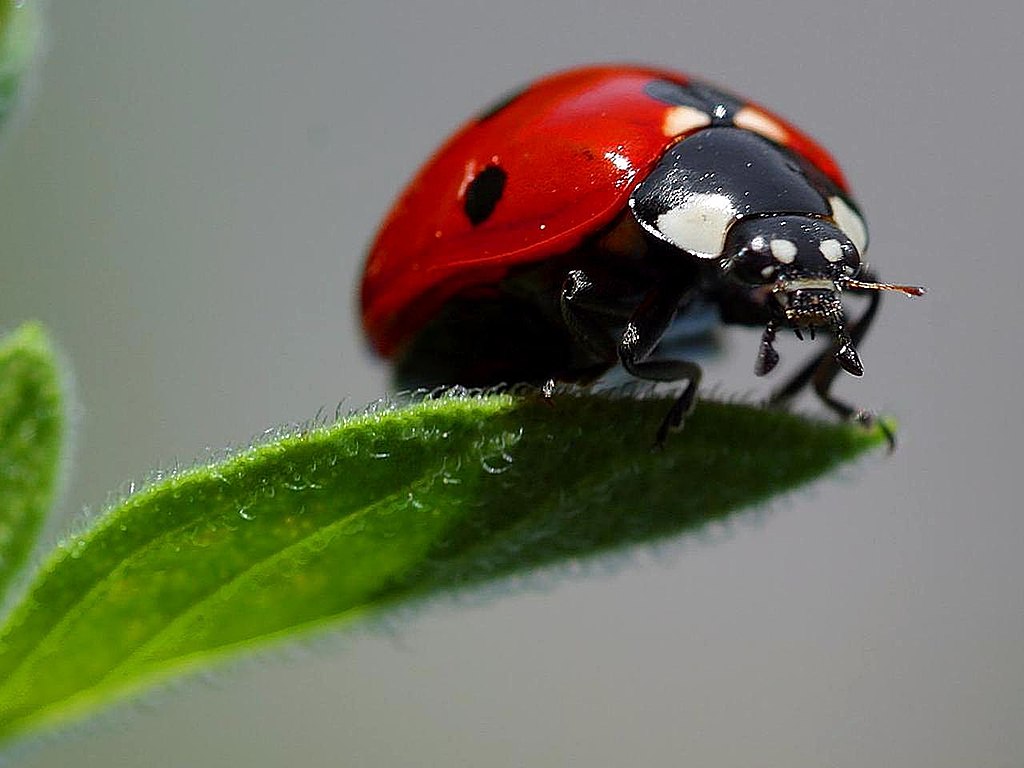 © Wikimedia.org/Jon Sullivan, CC0
© Wikimedia.org/Jon Sullivan, CC0
Locusts (derived from the Vulgar Latin locusta, meaning grasshopper) are a group of certain species of short-horned grasshoppers in the family Acrididae that have a swarming phase. These insects are usually solitary, but under certain circumstances they become more abundant and change their behaviour and habits, becoming gregarious. No taxonomic distinction is made between locust and grasshopper species; the basis for the definition is whether a species forms swarms under intermittently suitable conditions. (Source: Wikipedia.org, CC BY-SA)
Amblyomma americanum, also known as the lone star tick, the northeastern water tick, or the turkey tick, or the 'Cricker Tick', is a type of tick indigenous to much of the eastern United States and Mexico, that bites painlessly and commonly goes unnoticed, remaining attached to its host for as long as seven days until it is fully engorged with blood. It is a member of the phylum Arthropoda, class Arachnida. The adult lone star tick is sexually dimorphic, named for a silvery-white, star-shaped spot or 'lone star' present near the center of the posterior portion of the adult female shield (scutum); adult males conversely have varied white streaks or spots around the margins of their shields. (Source: Wikipedia.org, CC BY-SA)
The Madagascar hissing cockroach (Gromphadorhina portentosa), also known as the hissing cockroach or simply hisser, is one of the largest species of cockroach, reaching 5 to 7.5 centimetres (2 to 3 inches) at maturity. They are native to the island of Madagascar, which is off the African mainland, where they are commonly found in rotting logs. It is one of some 20 known species of large hissing roaches from Madagascar, many of which are kept as pets, and often confused with one another by pet dealers; in particular, G. portentosa is commonly confused with G. oblongonota and G. picea. Unlike most cockroaches, they are wingless. They can reproduce asexually, but usually reproduce sexually. They are excellent climbers and can scale smooth glass. Males can be distinguished from females by their thicker, hairier antennae and the very pronounced 'horns' on the pronotum. Females carry the ootheca internally, and release the young nymphs only after her offspring have emerged within her. As in some other wood-inhabiting roaches, the parents and offspring will commonly remain in close physical contact for extended periods of time. In captivity, these insects have been known to live up to 5 years. They feed primarily on vegetable material. (Source: Wikipedia.org, CC BY-SA)
A maggot is the larva of a fly (order Diptera); it is applied in particular to the larvae of Brachycera flies, such as houseflies, cheese flies, and blowflies, rather than larvae of the Nematocera, such as mosquitoes and crane flies. As with fleas and ticks, maggots can be a threat to household pets and livestock, especially sheep. Flies reproduce rapidly in the summer months, and maggots can come in large numbers, creating a maggot infestation and a high risk of myiasis (a maggot infestation of living tissue) in sheep and other animals. Humans are not immune to the feeding habits of maggots and can also contract myiasis. Interaction between humans and maggots usually occurs near garbage cans, dead animals, rotten food and other breeding grounds for maggots. (Source: Wikipedia.org, CC BY-SA)
Mayflies (also known as shadflies or fishflies in Canada and the upper Midwestern United States, as Canadian soldiers in the American Great Lakes region, and as up-winged flies in the United Kingdom) are aquatic insects belonging to the order Ephemeroptera. This order is part of an ancient group of insects termed the Palaeoptera, which also contains dragonflies and damselflies. Over 3,000 species of mayfly are known worldwide, grouped into over 400 genera in 42 families. Mayflies have ancestral traits that were probably present in the first flying insects, such as long tails and wings that do not fold flat over the abdomen. Their immature stages are aquatic fresh water forms (called 'naiads' or 'nymphs'), whose presence indicates a clean, unpolluted and highly oxygenated aquatic environment. They are unique among insect orders in having a fully winged terrestrial preadult stage, the subimago, which moults into a sexually mature adult, the imago. (Source: Wikipedia.org, CC BY-SA)
Mealybugs are insects in the family Pseudococcidae, unarmored scale insects found in moist, warm habitats. Many species are considered pests as they feed on plant juices of greenhouse plants, house plants and subtropical trees and also act as a vector for several plant diseases. Some ants live in symbiotic relationships with them, protecting them from predators and feeding off the honeydew which they excrete. (Source: Wikipedia.org, CC BY-SA)
Mole crickets are members of the insect family Gryllotalpidae, in the order Orthoptera (grasshoppers, locusts, and crickets). Mole crickets are cylindrical-bodied, fossorial insects about 3–5 cm (1.2–2.0 in) long as adults, with small eyes and shovel-like fore limbs highly developed for burrowing. They are present in many parts of the world and where they have arrived in new regions, may become agricultural pests. (Source: Wikipedia.org, CC BY-SA)
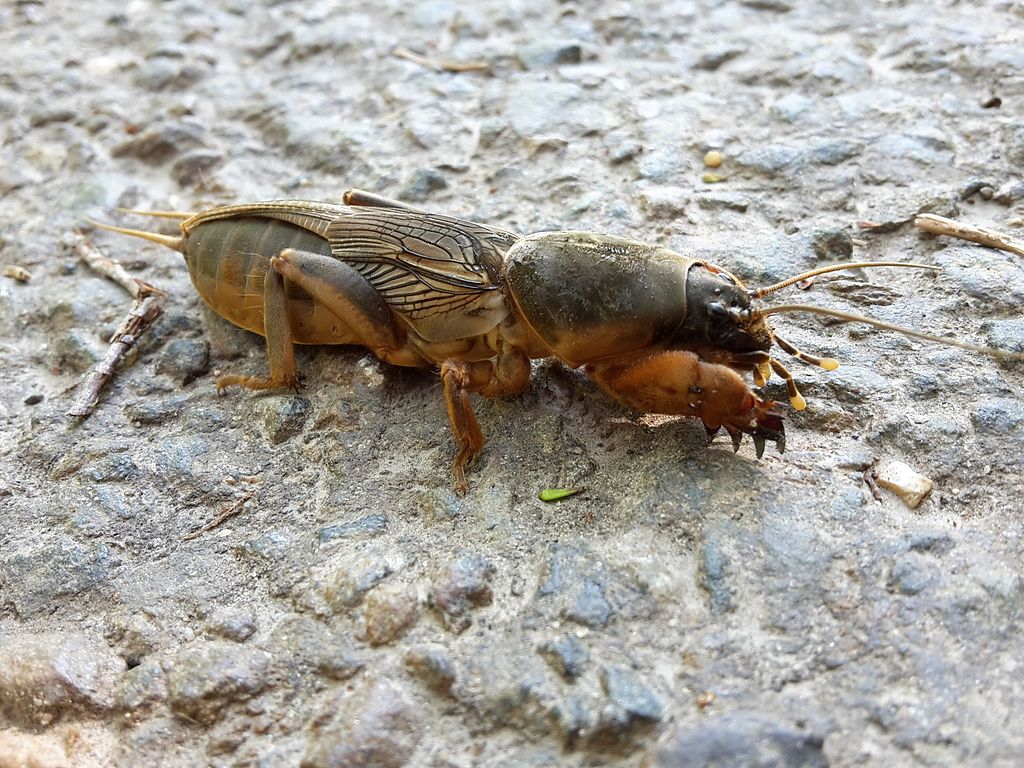 © Wikimedia.org/Tobias b köhler, CC BY-SA
© Wikimedia.org/Tobias b köhler, CC BY-SA

Time for recess! Post a comment, ask a question or write a review. Feel free to let us know what you think!
This app does not work for italian patente in French language. A bit frustrating to use
Tres intéressant , ça aide énormément pour bien analyser les questions et les réponses. Merci bcp
Carte du Permis de Conduire Classic AB Routiére Gillera Runner Dynamic Américaine
C'est un peu dificir d'etudies de règles de lå circulation sur internet, ici en Sweden pas de livres en france alors comment nous devon faire?
j'ai eu 1/ fin de l'autoroute 2/ fin de l'autoroute 3/ x 4/ y je prends la réponse 1, on me dit que j'ai faux et que j'aurais dû choisir 2... "lumière tamisée" pour feux de croisement, traduction vraiment approximative... Bon en gros c'est juste un quizz panneaux, ça me permet de découvrir un peu, mais je reste sceptique sur la qualité du tout. Je remercie l'effort.
Je viens de passer aujourd'hui le vrai test au DLT, je vous assure que ça n'a pas grand chose à voir...il y a des questions sur la législation, l'entretien, de plus, on demande dans une série de réponse laquelle est correcte, or, parfois, il y a plusieurs réponses correctes !! On fait quoi...très déçu par l'esprit de ce contrôle